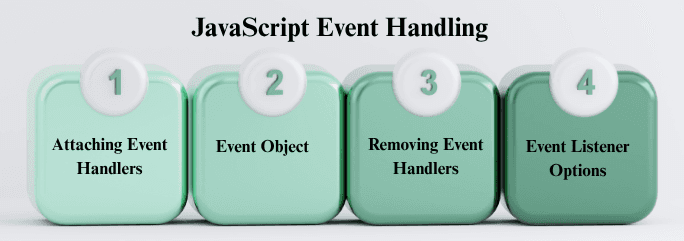Event Handling in JavaScript
Event handling is the process of responding to events when they occur in a web page or application. JavaScript allows you to register functions (event handlers) that run whenever a specific event is triggered.

1. Attaching Event Handlers
There are three main ways to handle events:
a) Inline HTML Attribute (Not recommended)
Assign a function directly in HTML using the on attribute.
<button onclick="alert('Button clicked')">Click Me</button>
b) Using DOM Element Properties
Assign a function to the on<Event> property of an element.
const btn = document.getElementById("myButton");
btn.onclick = () => console.log("Button clicked");
c) Using addEventListener (Recommended)
Registers one or more handlers for an event.
const btn = document.getElementById("myButton");
btn.addEventListener("click", () => console.log("Clicked!"));
2. Event Object
When an event occurs, the handler receives an event object with useful information:
element.addEventListener("click", (event) => {
console.log("Event type:", event.type);
console.log("Target element:", event.target);
});
Common properties:
event.type→ type of the event (e.g.,"click")event.target→ element that triggered the eventevent.currentTarget→ element the handler is attached toevent.preventDefault()→ prevent default browser behaviorevent.stopPropagation()→ stop event from bubbling up
3. Removing Event Handlers
You can remove handlers when they’re no longer needed using removeEventListener:
function handleClick() {
console.log("Clicked!");
}
btn.addEventListener("click", handleClick);
// Remove later
btn.removeEventListener("click", handleClick);
4. Event Listener Options
- capture: Determines whether the event is captured in the capturing phase.
- once: If
true, the handler runs only once and is automatically removed. - passive: If
true, the handler never callspreventDefault()(improves scrolling performance).
btn.addEventListener("click", () => console.log("Clicked once"), { once: true });

